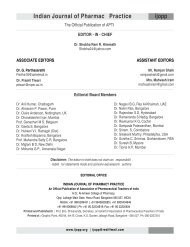Jul-Sep, 2012 - Indian Journal of Pharmacy Practice
Jul-Sep, 2012 - Indian Journal of Pharmacy Practice
Jul-Sep, 2012 - Indian Journal of Pharmacy Practice
You also want an ePaper? Increase the reach of your titles
YUMPU automatically turns print PDFs into web optimized ePapers that Google loves.
Mahendra Kumar BJ - Drug Induced Syndromes: An OverviewSerotonin Syndrome: Serotonin Syndrome is a toxic statelargely attributable to the changes in the sensitivity <strong>of</strong>serotonin receptor system, resulting from increasedserotonergic activity in central neurologic system, due to8serotonergic agents either in overdose or in combination.Causative drugs: L-tryptophan, Amphetamine, Lithium,Dextromethorphan, Merperidine, Fluoxetine, Trazodone,9Venlafaxine, Buspirone.Symptoms: Neuromuscular (clonus, myoclonus, tremor,hyperreflexia) and autonomic (fever, mydriasis, tachycardia,tachypnea) symptoms, mental status changes (confusion,9agitation) and may result in death in severe cases.Treatment: The main and foremost therapy is the cessation <strong>of</strong>the medication and the syndrome usually resolves within 24hours after the withdrawal <strong>of</strong> the causative drug. If serotoninsyndrome has occurred as a result <strong>of</strong> an acute overdose,activated charcoal may be beneficial soon after the ingestion.Supportive care is the mainstay <strong>of</strong> treatment. Hyperthermiashould be treated with aggressive external cooling measuressuch as ice, mist, fans and a cooling blanket. Rigidity,seizures, and agitation are treated with Benzodiazepines. Onestudy revealed that the severe symptoms can be successfullytreated with Cyproheptadine (5-hydroxytryptamine9antagonist).Red Man Syndrome (Red-Neck Syndrome /RMS): Red-Neck syndrome is characterized by pruritus; erythema <strong>of</strong> theface, neck, and upper torso; and in severe cases, angioedema10, 11and cardiovascular collapse.Causative drugs: Vancomycin, Cipr<strong>of</strong>loxacin, Amphotericin11B, Rifampicin and Teicoplanin.Symptoms: Sensation <strong>of</strong> burning and itching, agitation,11dizziness, headache, chill, fever and perioral paresthesia.Treatment: The effects <strong>of</strong> red man syndrome can be relievedby antihistamines. Pretreatment with hydroxyzine cans i g n i f i c a n t l y r e d u c e e r y t h e m a a n d p r u r i t u s .Diphenhydramine hydrochloride intravenously or orally can11abort most <strong>of</strong> the reactions.Blue-Gray Syndrome: Blue gray syndrome is anamiodarone related hyperpigmentation considered as a skin12storage disease secondary to drug deposition.12, 13, 14Causative drug: Amiodarone.Symptoms: Blue-gray skin pigmentation, dyspnea, cough and12, 13, 14fever. (Fig 2)Treatment: Discontinuation <strong>of</strong> the causative agent withoutintroducing other medication is considered as the mostpracticed therapy in clinical setup. Careful and regular long13, 14term follow-up is mandatory.Severe Dapsone Hypersensitivity Syndrome: Adversereactions to Dapsone, a potent anti-inflammatory, antiparasiticcompound, first line drug for leprosy includedramatic, generalized hypersensitivity syndrome termed asDapsone syndrome which has a frequency <strong>of</strong> 0.2% - 0.5% inpatients on Dapsone therapy typically begins with several15weeks <strong>of</strong> starting the drug.15, 16, 17Causative drug: Dapsone.Symptoms: High fever lasting for about 4-5 days associatedwith malaise, sore throat, dysphagia, productive cough, and a16pruritic rash, methamoglobinemia and hemolytic anemia.(Fig 3) .Treatment: Patients can be treated with corticosteroids bothorally (Prednisolone 40 mg/d) and topically (Beclomethasonedipropionate ointment 0.025%, 2 times a day). Cetirizine andHydroxyzine are also given for the management <strong>of</strong> Dapsone16syndrome.Neuroleptic Malignant Syndrome (NMS): NMS is a rare,but sometimes fatal, adverse reaction <strong>of</strong> neuroleptics18characterized principally by fever and rigor.Causative drugs: Butyrophenones, Phenothiazines,Thioxanthenes, Hydroxyzine, Reserpine;, Amitriptyline,Amoxapine, Desipramine, Maprotiline, Phenelzine,Tranylcypromine, Diazepam, Lorazepam, Carbamazepine,Phenytoin, Amantadine, Bromocriptine, Levodopa,18Lithium.Symptoms: Dopaminergic blockade cardinal featuresincluding autonomic dysfunction, altered mental status,muscular rigidity, hyperthermia, cogwheel rigidity,dyskinesia, dysphagia, festinating gait, lead pipe musclerigidity, oculogyric crisis and opisthotonos are seen in19patients.Treatment: Strong suspension <strong>of</strong> NMS neuroleptics should bedone immediately. Supportive measures are <strong>of</strong> greatimportance especially rehydration and cooling.Bromocryptine and Dantrolene given in divided doses orally20or parenterally up to 60mg per day.Nicolau Syndrome (Livedoid Dermatitis/NS): NicolauSyndrome is a rare adverse drug reaction with unknown21pathogenesis at the site <strong>of</strong> intramuscular drug injection.Causative drugs: Non-steroidal Anti-Inflammatory Drugs,21Corticosteroids, and Penicillin.Symptoms: Pain around the injection site soon after injection,followed by erythema, livedoid patch, haemorrhagic patch,finally resulting into the necrosis <strong>of</strong> skin, subcutaneous fat,22and muscle tissue. (Fig 4)Treatment: Treatment ranges from local care to surgicalintervention. Antibiotic use is restricted to cases with signs<strong>Indian</strong> <strong>Journal</strong> <strong>of</strong> <strong>Pharmacy</strong> <strong>Practice</strong> Volume 5 Issue 3 <strong>Jul</strong> - <strong>Sep</strong>, <strong>2012</strong> 14
















